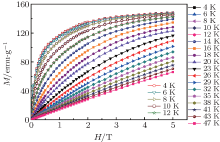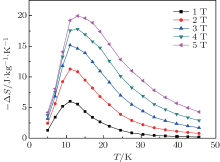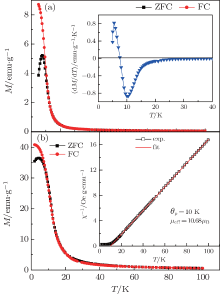†Corresponding author. E-mail: jshen@mail.ipc.ac.cn
*Project supported by the National Natural Science Foundation of China (Grant Nos. 51322605, 11104337, 51271192, and 11274357) and the Knowledge Innovation Project of the Chinese Academy of Sciences.
A large reversible magnetocaloric effect accompanied by a second order magnetic phase transition from PM to FM is observed in the HoPd compound. Under the magnetic field change of
The magnetic refrigerator is based on the magnetocaloric effect (MCE), which plays an important role in the refrigeration area for its higher energy efficiency and lower environmental hazard, especially, compared with the conventional gas compression refrigeration.[1– 4] The advanced magnetic materials are crucial for the magnetic refrigerant application, so it is necessary to go on exploring the advanced magnetic refrigerant materials with a large isothermal magnetic entropy change (Δ SM) and/or a large adiabatic temperature change (Δ Tad).[5] Up to now, many magnetic materials with large -Δ SM have been found, such as LaFe13 − xSix, [6– 8] MnFeP0.45As0.55, [9– 11]and Gd5Si2Ge2.[12– 14] The MCE materials working at room temperature can reduce the emission of green house gases. So much attention has been paid to search for magnetic refrigerants near room temperature.[15] On the other hand, the materials working at the low temperature regime are important for their potential applications in special technological areas, such as space science, liquefaction of hydrogen in the fuel industry, and liquefaction of helium, and can also help the facility to reach millikelvin.[16]
Until now, only the paramagnetic salts such as Gd3Gd5O12, GdLiF4, and GdF3[17, 18]have been commercially used. However the paramagnetic salts exhibit small MCE and strongly depend on the temperature. The rare earth-transition metal intermetallic compounds with ferromagnetic (FM) to paramagnetic (PM) transition or antiferromagnetic (AFM) to FM metamagnetic transition are believed to possess large MCE, and a series of materials have been reported, such as ErMn2Si2, [19] ErCr2Si2, [20]ErRu2Si2, [21] HoCuSi, [22] TmGa, [23] and TmCuAl.[24] They can be expected to have effective commercial applications in the technology of magnetic refrigeration at low temperature. In this paper, we report a study on the magnetic and magnetocaloric properties of the HoPd compound. The reversible 
The polycrystalline sample of HoPd was synthesized by arc melting of stoichiometric amounts of the elements with purity better than 99.9 at.% in argon atmosphere on a water-cooled copper hearth using a titanium zirconium alloy as the getter (the content of Ho was 3 at.% more than the theoretical value). The ingot was melted three times with the button being turned over after each melting to ensure the homogeneity. The sample was annealed at 1123 K for 7 days, and a subsequent quenching to room temperature was performed to obtain the crystalline sample. Powder X-ray diffraction (XRD) measurements with Cu Kα radiation were performed at room temperature to identify the crystal structure and the lattice parameters. Magnetizations were measured by employing a commercial superconducting quantum interference device (SQUID) magnetometer, model MPMS-7 from Quantum Design Inc.
Figure 1 shows the typical temperature dependence of the magnetization M(T) for the HoPd compound under an applied magnetic field of H = 0.01 T. The compound exhibits a magnetic transition from FM to PM, and the Curie temperature (TC) is determined to be 10 K, defined at the maximum slope of the M– T curve. It can be seen that there is almost no thermal hysteresis between the ZFC and FC curves as observed usually in SOPT when the temperature increases above TC. However, a significant thermal irreversibility is clearly observed below TC. The thermomagnetic irreversibility can be observed in many cases, such as spin-glass systems, materials with competing magnetic interactions, and materials with high anisotropy and low ordering temperature, [25] where the domain wall width could be comparable to the lattice spacing, thus resulting in a large pinning effect.[26] Considering the magnetic anisotropy due to the large orbital angular momentum in Ho atoms (or ions) and low TC for HoPd, the thermomagnetic irreversibility is likely arising from the narrow domain wall pinning effect. With increasing magnetic field, the thermomagnetic irreversibility becomes smaller as shown in Fig. 1(b), and vanishes completely under a higher field. This indicates that the higher magnetic field would provide more energy for the domain walls to conquer the barriers of the pinning effect, thus reducing the irreversibility. The inset of Fig. 1(b) shows the reciprocal magnetic susceptibility 

Figure 2 shows the isothermal magnetization curves as a function of the magnetic field, which was measured in applied fields up to 5 T in a wide temperature range. It can be seen from Fig. 2 that there is a considerable difference among the M– H curves for the HoPd compound in different temperature ranges. In the 20– 47 K temperature range, the field dependence of the magnetization shows a linear relation, whereas the isothermal curves for TC< T < 20 K show an appreciable nonlinearity. The curvatures in the M– H curves above TC probably indicate the existence of short-range FM correlations in the PM state. Additionally, it should be noticed that although the isothermal magnetization curves are gradually saturated with increasing magnetic field at considerably lower fields below TC, the complete saturation is not realized at 5 T. The magnetic moment per Ho atom reaches about 7.2μ B at 2 K and 5 T, which is much smaller than the theoretical ordered state magnetic moment of 10.6μ B for the Ho atom. The lack of complete saturation in the HoPd compound is likely due to the crystalline electric field. Additionally, the magnetization isotherms of HoPd measured on increasing (solid) and decreasing (open) fields around TC exhibit no magnetic hysteresis loss.
 | Fig. 2. Magnetization isotherms of HoPd collected in the temperature range of 4– 47 K; the M– H curves in decreasing field mode around TC (open symbols) are also shown. |
Figure 3 shows the Arrott plots of the HoPd compound in the temperature range of 4– 20 K. According to the Banwejee criterion, [27] a magnetic transition is expected to be of the first order when the slope of M2 versus H/M is negative, whereas it is of the second order when the slope is positive. Neither negative slope nor inflection point is observed in the Arrott plots of the HoPd compound, indicating a second-order FM– PM magnetic transition.
The MCE in terms of isothermal magnetic entropy change has been determined by utilizing Maxwell's relationship 



 | Fig. 4. Temperature dependences of magnetic entropy change in HoPd for different magnetic field changes. |
| Table 1. Magnetic ordertransition temperature T, – Δ SMmax and RC with the field change of 2 T for HoPd and other MCE materials around 10 K. |
A high RC is another important requirement of a potential magnetic refrigerant, which is a measure of how much heat can be transferred between the cold and hot sinks in one ideal refrigerant cycle.[35] It is defined as 
The polycrystalline HoPd compound with a single phase has been synthesized. A reversible MCE without thermal and magnetic hysteresis loss has been observed in the compound, which originates from the second order magnetic phase transition from PM to FM. With the magnetic field change of 0– 5 T, 

| 1 |
|
| 2 |
|
| 3 |
|
| 4 |
|
| 5 |
|
| 6 |
|
| 7 |
|
| 8 |
|
| 9 |
|
| 10 |
|
| 11 |
|
| 12 |
|
| 13 |
|
| 14 |
|
| 15 |
|
| 16 |
|
| 17 |
|
| 18 |
|
| 19 |
|
| 20 |
|
| 21 |
|
| 22 |
|
| 23 |
|
| 24 |
|
| 25 |
|
| 26 |
|
| 27 |
|
| 28 |
|
| 29 |
|
| 30 |
|
| 31 |
|
| 32 |
|
| 33 |
|
| 34 |
|
| 35 |
|




